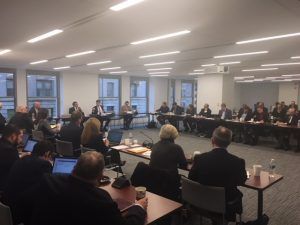 This past week, the Edison Electric Institute and EHS2 welcomed Larry Starfield, Acting Assistant Administrator for EPA’s Office of Enforcement, and Jeff Wood, Acting Assistant Attorney General for DOJ’s Environment and Natural Resources Division to discuss priorities for the environment in the Trump Administration. Discussions focused on new themes and Administration priorities including:
This past week, the Edison Electric Institute and EHS2 welcomed Larry Starfield, Acting Assistant Administrator for EPA’s Office of Enforcement, and Jeff Wood, Acting Assistant Attorney General for DOJ’s Environment and Natural Resources Division to discuss priorities for the environment in the Trump Administration. Discussions focused on new themes and Administration priorities including:
- Back to Basics – adhering to the rule of law and getting back to basics, executing and enforcing the nation’s environmental and occupational safety laws as Congress intended.
- Cooperative Federalism – commiting to working closely with states to advance environmental protection.
- Impartial Rule of Law – strengthening and preserving the long-standing principle of judicial impartiality.
- Pragmatic Decision-Making – improving compliance with federal laws with a focus on compliance assistance, backed by credible enforcement.
- Inter-Agency Collaboration – working across federal agencies to better coordinate decision-making and actions.
More specifically, discussions ranged across a host of DOJ and EPA policies encouraging companies to “find and fix” non-compliance through voluntary audits and compliance assistance; accelerating agency decisions involving Superfund cleanups and other agency approvals; zero tolerance for environmental criminal activities, with a particular focus on those involving serious risks of harm to public health or environment; and increasing enforcement across industry sectors to build a compliance culture where noncompliance rates are elevated.
Participants were reminded of DOJ’s Corporate Compliance Programs, under Section 9-28.800 of the Sentencing Guidelines, and what factors DOJ considers in whether a case will be pursued civilly or criminally:
While the Department recognizes that no compliance program can ever prevent all criminal activity by a corporation’s employees, the critical factors in evaluating any program are whether the program is adequately designed for maximum effectiveness in preventing and detecting wrongdoing by employees and whether corporate management is enforcing the program or is tacitly encouraging or pressuring employees to engage in misconduct to achieve business objectives. The Department has no formulaic requirements regarding corporate compliance programs. The fundamental questions any prosecutor should ask are: Is the corporation’s compliance program well designed? Is the program being applied earnestly and in good faith? Does the corporation’s compliance program work? In answering these questions, the prosecutor should consider the comprehensiveness of the compliance program; the extent and pervasiveness of the criminal misconduct; the number and level of the corporate employees involved; the seriousness, duration, and frequency of the misconduct; and any remedial actions taken by the corporation, including, for example, disciplinary action against past violators uncovered by the prior compliance program, and revisions to corporate compliance programs in light of lessons learned [1]Prosecutors should also consider the promptness of any disclosure of wrongdoing to the government. In evaluating compliance programs, prosecutors may consider whether the corporation has established corporate governance mechanisms that can effectively detect and prevent misconduct. For example, do the corporation’s directors exercise independent review over proposed corporate actions rather than unquestioningly ratifying officers’ recommendations; are internal audit functions conducted at a level sufficient to ensure their independence and accuracy; and have the directors established an information and reporting system in the organization reasonably designed to provide management and directors with timely and accurate information sufficient to allow them to reach an informed decision regarding the organization’s compliance with the law. See, e.g., In re Caremark Int’l Inc. Derivative Litig., 698 A.2d 959, 968-70 (Del. Ch. 1996).
and EPA’s Compliance-Focused EMS Enforcement Agreement Guidance and 12 principles of effective environmental management systems. EPA’s enforcement office is in the process of updating the Agency’s strategic plan due to Congress in February 2018 for FY 2018-2019. Two new goals will focus on improving compliance rates of the water sector and timeliness of the Agency’s review and approval of regulatory plans and permits.
If you are interested in joining EHS2, please contact Ken Maynard at ken.maynard@earthandwatergroup.com.




